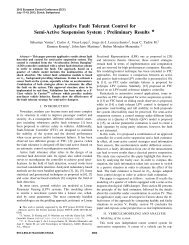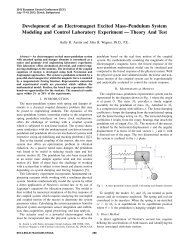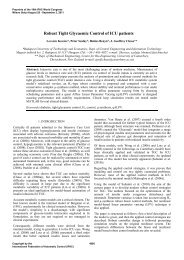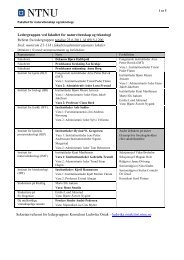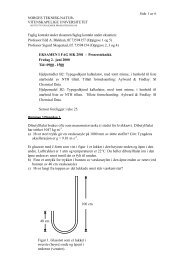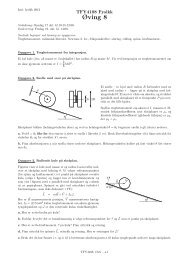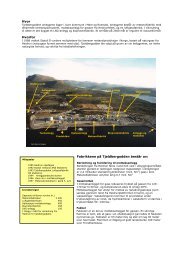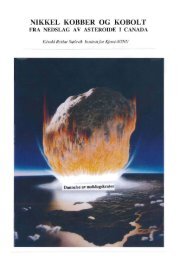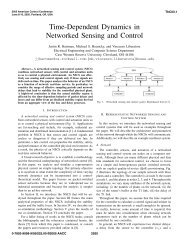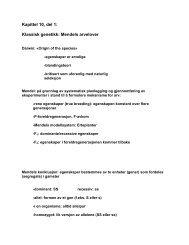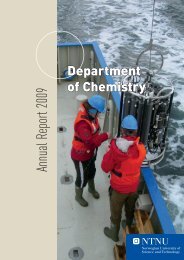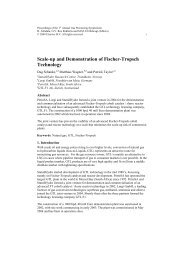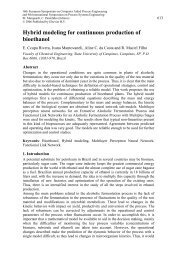CPC VI -- Chemical Process Control VI
CPC VI -- Chemical Process Control VI
CPC VI -- Chemical Process Control VI
You also want an ePaper? Increase the reach of your titles
YUMPU automatically turns print PDFs into web optimized ePapers that Google loves.
Nonlinear Model Reduction for Optimization Based <strong>Control</strong> of Transient <strong>Chemical</strong> <strong>Process</strong>es 23<br />
to use F = −A −1 B, the static gain at the reference point<br />
x ∗ , u ∗ to emphasize the input-state relation of the dynamics.<br />
An averaged gain in some neighborhood of the<br />
reference point can be used instead, i.e. F = −A −1 B,<br />
to reflect some of the nonlinearity in the calculation of<br />
M.<br />
Motivated by the stiffness occurring in many largescale<br />
systems, Pallaske (1987) suggests to choose the<br />
transformation such that the dynamics of the states can<br />
be approximately captured in a lower dimensional subspace.<br />
This translates to a minimization of the variance<br />
of the state in the directions of the coordinate axes of the<br />
reduced space. The transformation T = [d1, d2, . . . , dn],<br />
with di being the normalized eigenvectors of the covariance<br />
matrix M, results in such a choice (see below).<br />
The close relation of Pallaske’s method to model reduction<br />
by balancing can be identified as follows. A<br />
choice of F = F c = B = ∂f<br />
∂u |x ∗ ,u ∗ and F = F o = C T =<br />
( ∂h<br />
∂x |x ∗ ,u ∗)T and ρ determined from (25) with k = 1 results<br />
in the local controllability or observability Gramian<br />
(17), (18) of the system (8) at x ∗ emphasizing the inputstate<br />
or the state-output relation of the dynamics. These<br />
matrices are used in linear balancing (Moore, 1981) to<br />
construct the transformation T c,o. This transformation<br />
aims at a removal of the weakly controllable and observable<br />
subspaces. It is in contrast to Pallaske’s objective<br />
which is a removal of the fast non-dominant states. Obviously,<br />
a transformation determined from a linearization<br />
of the nonlinear model does not exactly balance the<br />
nonlinear system in the sense of Scherpen (1993) but<br />
may qualify as a useful empirical approximation which<br />
at least is consistent with the linear theory. In fact, Wisnewski<br />
and Doyle III (1996a) successfully demonstrate<br />
the applicability of a related approach. They compute<br />
the transformation T from the left and right eigenvectors<br />
of the Hankel matrix, i.e. the product of the observability<br />
and controllability Gramians, of a linearization of the<br />
nonlinear model at a stationary reference point.<br />
Empirical balancing of nonlinear systems has been recently<br />
introduced by Lall et al. (1999). They suggest empirical<br />
controllability and observability Gramians, M c<br />
and M o, which are closely related to Equation 22. Impulse<br />
responses of varying magnitude are chosen in the<br />
set G to compute M c, whereas responses to different initial<br />
conditions are used in the set G to compute M o. In<br />
this case, Lall et al. (1999) use the covariances of the<br />
outputs y = h(x) in Equation 22 instead of the states<br />
x. These Gramians are used to empirically balance the<br />
nonlinear system as in the linear case. This approach<br />
has been adopted recently by Hahn and Edgar (Hahn<br />
and Edgar, 1999, 2000).<br />
A completely different approach of determining the<br />
transformation matrix is reported in structural dynamics<br />
(Slaats et al., 1995). As in modal reduction techniques<br />
for linear systems (Litz, 1979; Bonvin and Mel-<br />
lichamp, 1982), the transformation matrix T is formed<br />
by the dominating modes of the second order model (the<br />
eigenvectors associated with complex conjugate eigenvalues).<br />
However, these modes are taken as functions of the<br />
displacement of a node in a mechanical structure to account<br />
for the nonlinearities. Analytical expressions are<br />
derived to determine the modes for the model linearized<br />
at the initial condition and for first and second order<br />
sensitivities of the modes with respect to the nodal positions.<br />
The transformation matrix is then computed from<br />
these quantities. The method carries over to first order<br />
process systems models, but seems only appropriate for<br />
less severe nonlinearities in the vicinity of an operating<br />
point.<br />
State space decomposition<br />
According to step 2 of the general projection method, the<br />
transformed space has to be decomposed next into two<br />
subspaces capturing the dominant and the non-dominant<br />
states, respectively.<br />
Scherpen (1993) suggests to use the magnitude of the<br />
singular value functions occuring in the transformed observability<br />
and controllability functions in some domain<br />
of the state space as an indication for weakly controllable<br />
and observable subspaces. Those states with large values<br />
of the singular value functions are grouped into the vector<br />
of dominant states z1, and the remaining state variables<br />
form z2. The same strategy is employed by Lall<br />
et al. (1999) and Hahn and Edgar (1999, 2000). They<br />
analyse the singular values of the empirical Gramians<br />
and delete those states with small singular values indicating<br />
weak observability and controllablility as in the<br />
linear case (Moore, 1981).<br />
Pallaske (1987) poses an optimization problem to<br />
bound the normalized L2-error between the approximate<br />
and the original state vectors ˜x and x to a user-defined<br />
tolerance ε0 by varying m, the dimension of z1. The<br />
solution to this problem is<br />
subject to<br />
m = min k (26)<br />
k<br />
µi ≥ (1 − ε 2 0) trace {M}<br />
i=1<br />
with µ1 > µ2 · · · ≥ µn being the eigenvalues of M.<br />
Hence, the first m normalized eigenvectors di , i = 1, . . . n<br />
of M span the subspace for the dominant transformed<br />
states. Consequently, T 1 = [d1, . . . , dm] and T 2 =<br />
[dm+1, . . . , dn] in Equation 11. The same approach has<br />
been adopted by Löffler and Marquardt (1991).<br />
In some cases, the choice of the dominant states may<br />
be based solely on physical insight. This selection is<br />
typically done without transformation in the original coordinates.



